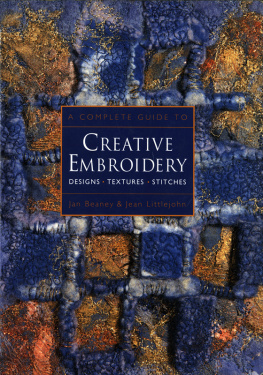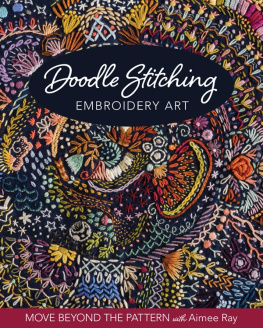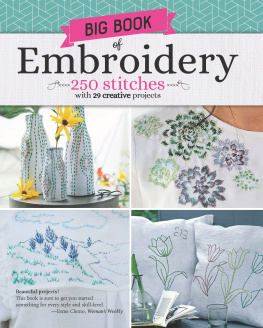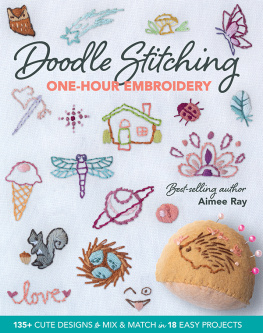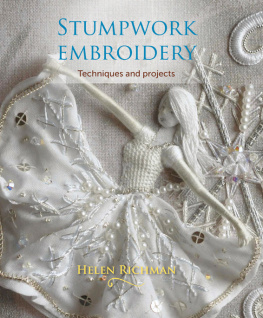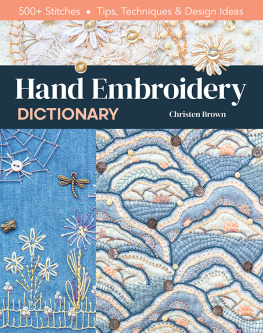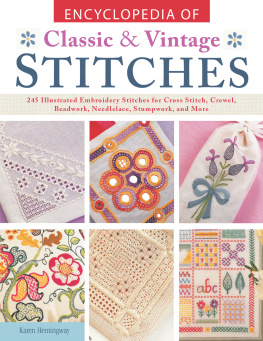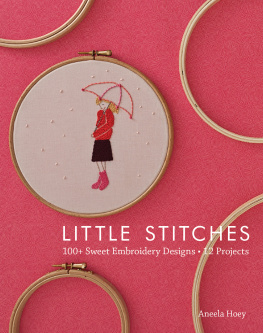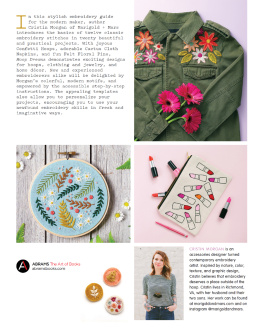A COMPLETE GUIDE TO
CREATIVE EMBROIDERY

colourful abstract embroidery, based on cave formations, by Diane Kelly. The pattern of vertical stripes relates to the stalagmites and stalactites of the original cave.
A COMPLETE GUIDE TO
CREATIVE EMBROIDERY
DESIGNS TEXTURES STITCHES
Jan Beaney and Jean Littlejohn
To Steve and Philip for their continuing support and encouragement
First published as eBook in the United Kingdom in 2014 by
Batsford, an imprint of Pavilion Books Company Limited
1 Gower Street
London WC1E 6HD
www.pavilionbooks.com
This printed edition published 1997
Reprinted 2000, 2001, 2002, 2003, 2005
First published in 1991 by Century Editions,
an imprint of the Random Century Group Ltd,
Copyright Jan Beaney and Jean Littlejohn 1997
Copyright Design to Embroiderer Jean Littlejohn 1997
Copyright Stitched Images Jan Beaney 1997
The right of Jan Beaney and Jean Littlejohn to be identified as Author of this work has been asserted by them in accordance with the Copyright, Designs and Patents Act 1988.
eISBN 9781849942270
All rights reserved. No part of this publication may be reproduced, stored in a retrieval system, or transmitted in any form or by any means, electronic, mechanical, photocopying, recording or otherwise, without the prior writen permission of the copyright owner.
Photography by Dudley Moss
Edited by Cindy Richards
Still Life photography on pages 10, 22, 35, 46, 49 (top), 94 (bottom), 96, 121 (top), 122 and 124 by Patrick McLeavey
Location photography by Jan Beaney, Jean Littlejohn, Philip Littlejohn, Steve Udall
Stitch Illustrations by Dennis Hawks
Front cover: Handmade felt by Gwen Hedley
Back cover: Tree Celebration II by Jean Littlejohn
PREFACE
Embroidery can be a sharing experience and it is stimulating to exchange ideas. We have been most fortunate over a period of years not only to share a friendship and a passion for stitched textiles but also to be in a position to work as a team, bouncing ideas from one to another.
We are not always aware of who initiates the starting points but being in a position to talk and mull over these thoughts enables us to plan a structured approach to our teaching as well as being an enjoyable experience.
Within this framework we retain our individual approaches and style of working.
There are many ways of achieving a piece of creative stitching and we would not presume that the approach we offer in these books is the only way.
For many years we have encouraged students to develop their ideas beyond the superficial by extended themes and this has been reflected in the way we have planned both books.
In some instances you may find the we have compiled useful.
We believe that many people are capable of designing and stitching their own embroideries. Our students have found our methods reassuring. Our message is not to be intimidated but to enjoy learning to look and explore the creative potential of papers, fabrics and threads.

geometric design and canvas-work sample by Elizabeth Coughlan.
DESIGN TO EMBROIDER
Jean Littlejohn

.
CONTENTS
INTRODUCTION
The ability to draw and design is within the reach of everyone but lack of confidence so often prevents people from achieving their full potential.
In many cultures, drawing skills are part of a way of life and not held up as an exclusive gift available only to those with natural ability. Just as competence in writing, mathematics or music may be improved with practice and enthusiasm, so it is with drawing.
Through drawing we learn to see. We may think we know a familiar flower until asked to describe it accurately. By recording it on paper we cannot help but understand it better.
There are very few people who can sit in front of a blank sheet of paper and conjure up designs purely from imagination. Most of us need to look at a source of inspiration and from it develop ideas which will work in fabric and thread.
To do this it is necessary to be aware of the widest possible range of media and techniques in order to select those which suit our personal style and the embroideries we plan to work.
All of the techniques in the book are based on simple principles and, most importantly, capable of being carried out at home using accessible equipment.
It has become apparent that many people would like a structured approach towards designing which will not only inspire images for embroidery, but establish confidence and act as a springboard for new and stimulating ways of working.
This book contains a range of ideas from basic backgrounds and simple mark-making through to more complex multimedia work. The ideas are there to inspire rather than follow slavishly, but the guidelines will encourage those first marks.
It is important to remember the need to experiment and not to give up if first attempts do not achieve the desired effect. Several of the designs featured in the book were done by people who started out with very little confidence in either drawing or designing, others by experienced artists. Just remember that with practice and curiosity anything is possible.

a tissue paper collage and painted pattern by Clmence Gilder.
MARK-MAKING MATERIALS
A visit to any art shop will reveal the huge range of paints, crayons, inks, pencils, papers and glues available. These provide exciting design possibilities but hasty choices can result in costly mistakes. How do you decide which ones to buy? Many people have visually appealing boxed sets of colouring media which remain unused. Ideally it would be marvellous to be let loose in an art shop and try everything before buying, indeed some shops have samples for this purpose, so it is always worth asking. Being watched doesnt matter as simple lines and smudges will suffice to indicate if you like the feel, the mark or even the sound a material makes on the paper. Cont pencils have a wonderful colour range and blend beautifully but can make a rasping noise on textured paper which you may find unpleasant, so it is wise to try them before committing yourself to a complete box.
Before buying anything search your house, ask members of your family for contributions, and I bet youll be amazed at the range of mark-making materials you already have. For linear marks fibre tip pens, pencils, ink pens and ballpoint pens will offer a very wide range. Alternatively, if you are part of a group, pool your resources for one session and try each others materials. Using simple marks build up a chart making careful note of the name and type of material used next to each one with additional comments on its handling and potential it will prove an invaluable source of reference.
Selecting your materials need not be complicated if a little common sense is applied. Look upon the various types of colouring media as pigments bound together in different ways. Being aware of the composition will indicate what it does. Perhaps the most effective method of selection would be to consider the quality of mark you are seeking and think in terms of line, tonal values, boldness, subtlety, vibrancy, delicacy, coarseness and texture.
Next page
